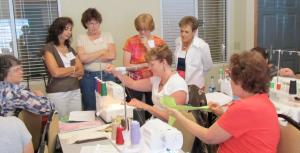You have a serger and aren’t sure what to do next. Do you remain afraid to plug it in or do you fearlessly embrace all it can do?
What we recommend for any serger owner (fearful or fearless) is a day or two with Mac Berg, sewing instructor and serger guru who has years of experience with these mechanical beasts. And that’s just what we did. On July 14, a group of ASG Chicago members crowed (literally) in a meeting room at the Holiday Inn Express in Riverwoods. (Writer’s note: Yep, the room was too cozy, but the facility was great. We definitely would recommend it as well as Tasty Catering for lunch!)

Mac Berg, in white t-shirt sitting at serger, spends time with ASG Chicago members.
Mac, who can be contacted for classes at [email protected], explained that a serger is like a drama set in an apartment building where the tenants don’t speak the same language; however, when they find ways to actually communicate then something wonderful happens. It can be dramatic, but there are ways to avoid or benefit from that drama. The key to using any serger, as Mac explained, is understanding the basics and building from there. For example, in her apartment complex drama:
- Lucy, the left most needle, has a controlling personality. She controls the seam.
- Rosie, the right needle, is very calm, and she adds stability to the building and to the stitch.
- Bambi, the upper looper, wants to be the center of attention and she dates Rual.
- Rual, the lover…opps…lower looper, workouts a lot and is very strong, though he instantly reacts to stress and tension.
Once you know that neighbors, it’s a matter of helping them get along in a balanced stitch kind of way. A couple other players every serger owner should know are Knife and Tension, the maintenance team of the complex.
- Tension can be tense. You can follow what the manual states, or you can use the additional tension tools that just about everyone owns, which are the thumb and index finger. Tension disks, Mac explains, are just squeezing the thread so if you want to alter a stitch, try squeezing the thread with just your fingers. Try it. Go ahead. Then when we adjust our tension dials, we can create decorative stitches. For example, if Bambie has had too many tasty beverages at a party, she is a bit loose and she visits the lower side of the fabric where Rual lives. This makes Rual then tightens up and he runs away from her into the arms of Rosie or Lucy. Oh, the drama!
- Knife can be a little more complicated. Everyone feels differently about disengaging the knife when serging or changing the set-up. Mac suggests trying avoid disengaging the knife because if you forget to re-engage the knife the damage to the machine can be costly. Rather than disengaging the knife, owners can practice and gain confidence to serge against the knife; just because it’s engaged doesn’t mean it has to cut the fabric. If you do disengage your knife, Mac strongly recommends putting notes, signs, or any reminder to re-engage it. Also, remember that the knife is nothing more than a pair of scissors attached to the machine and you control where it cuts.
Using the serger, like any machine, is about building confidence and that is best done by using it and taking notes. Take a piece of paper and note what is indicated in the manual and then as you play with it:
- Name of stitch
- Left Needle tension
- Right Needle tension
- Upper Looper tension
- Lower Looper tension
- Stitch Length
- Cutting width
- Differential Feed setting
- How the stitch should be used
- Attached (stable or tape) a sample of that stitch to the paper
Having this sample library will help when you want to remember what a change in the tension did to a stitch or how it gathered the fabric. Consider saving these papers in a binder with your manual for easy access.
As the day went on, Mac gave more nuggets of information to the class, such as:
- 3-thread wide is good to finish raw edges and to attach elastic. It’s the stretchiest stitch and most decorative.
- The closer the knife is to the needle, the more fabric it cuts; you can move it away from the needle, but try to avoid disengaging it.
- 4-thread is the perfect construction seam for knits.
- 5-thread seams are better for woven construction.
- Never put serger thread in your sewing machine, but sewing machine thread can be used in the serger.
- You can but more than one thread through a looper; think of it as a creative license to be decorative.
- The thicker the thread, the more the tension will need to be adjusted.
- Fingers are external tension devices.

